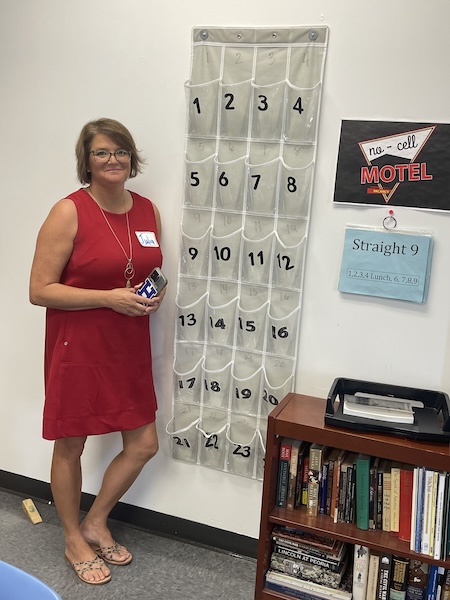State law requires ‘bell-to-bell’ restrictions
Public school districts in the Highlands adopted policies this month to align student cellphone restrictions with a newly enacted state law that requires a “bell-to-bell” ban.
The law, enacted in April as part of the state budget, applies to public schools, charter schools and Boards of Cooperative Educational Services (BOCES). It prohibits the use of smartphones and other internet-enabled personal devices by students during the school day, including at lunch, recess and study halls.
The law allows districts to provide exceptions for emergencies or to manage a student’s healthcare, for students with disabilities or individualized education programs, for translation services, or for students who are routinely responsible for the care of a family member.
After a meeting on Monday (July 21) with the president of the state teachers’ union and Capital Region administrators, Gov. Kathy Hochul said in a statement that her priority is ensuring that students receive “a high-quality education, free from constant clicking and scrolling.” She said on Thursday that about 300 districts had submitted their policies to the Education Department before the Aug. 1 deadline.
The Beacon school board, which last year banned student cellphone use during classes at Rombout Middle School and Beacon High School, extended its restrictions on Monday to align with state law. Beginning Sept. 2, students who bring phones to school will be required to store them in their lockers for the entire day.
If a student is found using a phone, it will be confiscated and placed in a locked space in an administrative office for the remainder of the day. The penalty for a second offense will be five school days locked in the office, and a third offense will be 10 school days. If a student is found using a phone a fifth time, it could be locked up each school day for the remainder of the academic year, Superintendent Matt Landahl told the board.

Cellphone restrictions will not change at the district’s four elementary schools, as students who bring cellphones are required to keep them in their storage cubbies or backpacks at all times.
An online survey conducted by the district in June showed support for the new restrictions from the 278 students, teachers, parents and caregivers who responded, Landahl said, but “there’s just an incredible variance in all of the details.”
Students said in the survey that they had grown to appreciate the district’s classroom ban on phones, which was adopted a year ago and allowed phone use between classes, at lunch and during recess, Landahl said. However, after adhering to that policy, students were surprised to learn that stricter rules were on the way.
Teachers asked for explicit language and consistent implementation of the policy. Some parents “had a lot of serious questions” about contacting their children during the day, either for logistical reasons or for emergencies, he said.

The state set aside $13.5 million for schools to purchase “storage solutions,” but Beacon’s allocation of $13,000 was far less than the $80,000 it would cost to outfit the middle and high schools with locking pouches, Landahl said. The district spent about half of the money to purchase lockboxes for administrative offices.
Rombout Principal Brian Soltish said Monday that students would be assigned lockers, whenever possible, close to their last-period class, to give them time to retrieve their phones before being picked up or boarding a bus. For middle school students, using a locker every day will be a shift “from what many are doing, which is just loading everything into their backpacks,” he said.
The district next month will distribute email addresses and phone numbers to parents or guardians who need to send messages to their children during the day. Students will be able to call their parents using school phones with permission. In the event of an emergency, Landahl said he will communicate with the community via email and robocalls, as he does now.
In Philipstown, the Haldane and Garrison school boards adopted policies this month that allow for storage in lockers, cubbies, the school office or a classroom. As in Beacon, the 2025-26 academic year begins in each district on Sept. 2.
The Garrison district, which has about 200 students in grades pre-K to 8, last year banned cellphone use during instructional hours at all grade levels. The Haldane district had a ban in place in the elementary and middle schools, where students who brought phones were told to store them in their lockers. Haldane High School students were allowed to have phones during the day but were required to stow them in repurposed shoe organizers — “no-cell motels” — during class.
Haldane Superintendent Gail Duffy said the district is “looking at what type of storage options make sense” to implement the state law. The stricter rules at the high school will allow administrators to reinforce “distraction-free learning,” and to remind students that “you can communicate and collaborate in person, making eye contact, having in-person conversations and not relying on the phone,” she said.
Garrison Superintendent Greg Stowell said the district surveyed its students and staff after last year’s ban, with teachers reporting that it “increased student engagement with academic tasks, improved classroom management and contributed to a more focused and productive learning environment.”
Many students, however, said “the policy had minimal impact on their ability to focus or interact socially with peers,” Stowell said. He added that “most students reported that the restriction did not reduce their overall time spent on social media. In fact, some noted an increase outside of school hours.”
Joey Asher contributed reporting.

